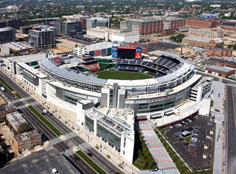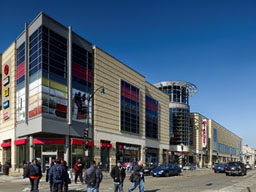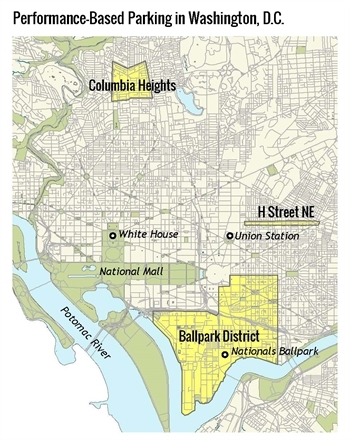
Arial view of National Park Stadium
Wikimedia Commons
Washington, D.C., like cities across the country, has begun to experiment with new and more effective ways to price its parking. Visitors to a number of the city’s most popular areas, from the DC USA shopping center to the Washington Nationals stadium, will experience the changes up close as the District Dept. of Transportation (DDOT) expands use of a new approach to manage parking availability, by pricing meters based on the changing demand for parking at different times of day.
Due to growing commercial and residential development, several years ago officials identified a need for improved parking management. In March 2008, DDOT first rolled out Performance Based Parking in a pilot zone in neighborhoods near the new Washington Nationals baseball stadium in the Ballpark District. By 2009, the program’s successes—which substantially increased meter revenues, providing new funding for affected neighborhoods—encouraged the city to expand into the neighborhood of Columbia Heights, where the bustling DC USA shopping center had just opened. More recently, in November 2012 DDOT introduced its program on the H Street NE corridor, which is increasingly an urban nightlife center. Further expansions into other neighborhoods—and eventually the entire city—are currently being planned.

DC USA Shopping Complex
Wikimedia Commons
With its gradual rollout, Washington D.C., has taken a cautious approach in implementing its new parking policies—and it plans to experiment to reach the right equilibrium. DDOT reserves the right each year to amend parking prices to reach the targeted occupancy rate of 85 percent, a figure recommended by parking expert Donald Shoup that encourages turnover and ensures a few vacant spaces for patrons willing to pay at any given time. Using license plate reader technology, District officials record occupancy data at meters and set rates based on the data. Rates rise and fall with demand; too few parkers might mean the rate is too high, while too few empty spaces might indicate the opposite. Prices are adjusted annually to meet the targeted 85 percent threshold.
The three performance-based parking districts are illustrated in the following map. Of the three zones, the Ballpark District is the largest, accounting for 145 blocks and 6,200 curbside parking spaces and includes sections of Capitol Hill. Columbia Heights is about one quarter the size, while the H Street Zone is smaller still.

Table 1 documents the general rate structure for 2011-2012 for all three areas, demonstrating the District’s varied approach to parking management. The Ballpark District uses different hourly rates, depending on whether a game is scheduled to occur or not. In Columbia Heights, the rates increase by the hour. In H Street NE, the rate varies between day and evening times. Each district enforces meters Monday through Saturday.
Table 1. Parking meter rate structure, 2011-2012.
| |
Ballpark District1 |
Columbia Heights1,2 |
H Street NE3 |
| Hourly Rate |
$1/2.50/2.50 /
$2/8/8 |
$2.50/3/3 |
$0.75 / 2 |
Time Limit
(until 6:30 p.m.) |
2 hrs. |
2 hrs. |
4 hrs. |
| Hours of Enforcement |
7 a.m.-9:30 p.m./
7 a.m.-10 p.m. |
7 a.m.-10 p.m. |
7 a.m.-6:30 p.m./
6:30 p.m.-10p.m. |
1Rates refer to the 1st through the 3rd hours; the Ballpark District is divided by non-game/game days
2Rates apply only to the 2900 through 3300 blocks of 14th St. NW, all else $2/hr.
3Rates enforced by time of day: First rate aligns with daytime, second with evening time enforcement
The initial implementation produced mixed results. License plate reader studies conducted during eight-hour intervals for three consecutive days in summer 2010 suggested that there is room for improvement. An average of 10 percent of metered blocks in the Ballpark District reached or surpassed the 85 percent occupancy rate threshold, compared to 9 percent of metered blocks in Columbia Heights. Nevertheless, 100 percent of Columbia Heights’ multi-space meters (solar-powered payment devices that accept coins and cards to manage multiple parking spaces) achieved or surpassed the 85 percent occupancy rate. Since launch, revenues in the pilot zones have been substantial, especially in the Ballpark District. Table 2 compares annual meter revenues between 2009 and 2012. Currently, revenues are equally split between Washington Metropolitan Area Transit Authority initiatives (i.e., rail, bus and paratransit) and neighborhood improvements within the pilot zones.
Table 2. Pilot zone meter revenue, 2009-2012.
| Annual Revenues |
Ballpark District |
Columbia Heights |
H Street NE1 |
| 2009 |
$575,000 |
$83,000 |
-- |
| 2010 |
$597,000 |
$52,000 |
-- |
| 2011 |
$1.5 million |
$124,000 |
-- |
| 2012 |
$1 million |
$117,000 |
$105,000 |
1Timeframe covers November 2012 through March 2013
Funds have contributed to the completion of a wide variety of improvement projects, such as streetscapes, enhanced sidewalks, bike facilities and transit signage. Specifically, these projects include Big Belly solar trash compactors, the Capital Bikeshare program and street repaving.
DDOT argues that the program has provided advantages to residents and businesses, which have flourished thanks to reduced traffic and easier-to-find parking spaces. But perhaps the greatest benefits have extended beyond the mundane joy of a readily available parking space, as community members have reacted positively to the use of performance parking revenues for projects in their neighborhoods.
MPC Research Assistant Parfait Gasana authored this post.
Solving the Parking Predicament Series
MPC’s Solving the Parking Predicament series offers an in-depth discussion of parking management. Beginning with a review of the parking problem and new strategies to solve them, each case study highlights best practices from around the country:
These case studies will show how parking can transform from a headache into a demand strategy that takes the stress out of parking for drivers, while supporting communities by increasing transportation options, building business activity, and boosting community ambience.
Through CMAP’s Local Technical Assistance program, MPC is working with the Wicker Park/Bucktown Special Service Area to analyze how variable priced parking—charging different rates for parking based on shifts in demand at different times or days of the week—can achieve just the right number of available parking spots. The study also will determine if variable priced parking would create additional revenue to support neighborhood sidewalk and transit improvements—a spot-on solution for drivers, businesses and the community.